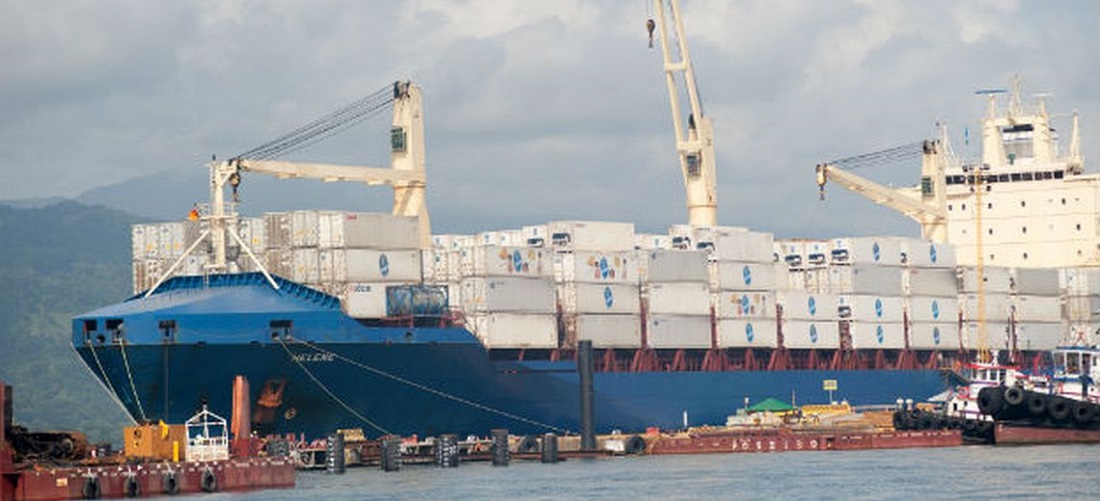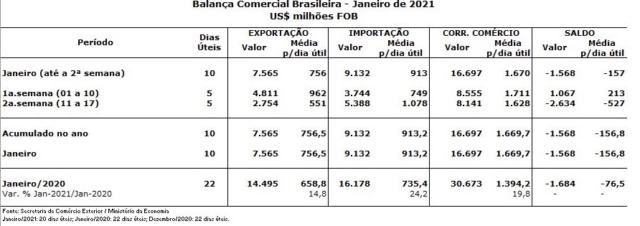
Trade balance shows US$ 2.63 bi deficit in the second week of January
Jan, 18, 2021 Posted by Ruth HollardWeek 202103
Data released on Monday, January 18, by the Foreign Trade Secretariat (SECEX) of the Ministry of Economy point out that the Brazilian trade balance registered a deficit of US $ 2.634 billion referring to the second week of January 2021 – with five working days – as a result of exports worth US$ 2.754 billion and imports of US$ 5.388 billion.
In the month, exports totaled US$ 7.565 billion and imports totaled US$ 9.132 billion, with a deficit balance of US $ 1.568 billion.
Analysis of the month
In exports, comparing the daily average until the second week of January 2021 (US$ 756.46 million) with that of January 2020 (US$ 658.84 million), there was an increase of 14.8%, due to the increase in sales of products from the Extractive Industry (40.1%), Agriculture and Livestock (5.8%) and the Manufacturing Industry (6.3%).
The increase in exports was mainly driven by growth in sales of the following products from the Extractive Industry: Iron ore and concentrates (+ 60.8%); Crude petroleum or bituminous mineral oils, raw (+ 14.3%); Copper ores and concentrates (+ 107.8%); Other ores and concentrates of base metals (+ 53.3%) and Stone, sand, and gravel (+ 67.6%).
Concerning Agriculture, growth was driven mainly by the increase in sales of Raw cotton (+ 40.3%); Unground corn, except sweet corn (+ 50.9%); Unroasted coffee (+ 37.3%); Wheat and rye, unground (+ 288.2%) and Spices (+ 73.8%). Concerning the Manufacturing Industry, the highlight was the growth in sales of sugars and molasses (+ 65.4%); Soybean meal and other animal feed, excluding unground cereals; Meat and other animal meal (+ 51.1%); Gold, non-monetary, excluding gold ores and concentrates (+ 38.9%); Pig iron, Spiegel iron, and sponge iron, iron or steel granules and powder, and iron alloys (+ 33.0%); and Alcohols, phenols, phenols-alcohols, and their halogenated, sulfonated, nitrated or nitrosated derivatives (+121.3 %).
In imports, the daily average until the second week of January 2021 (US$ 913.21 million) was 24.2% above the January average of last year (US$ 735.37 million). In this comparison, expenses increased, mainly with Agriculture (3.9%) and with products from the Manufacturing Industry (25.0%). On the other hand, there was a decrease in spending on purchases from the Extractive Industry (-3.9%).
The increase in imports was mainly driven by the growth in purchases of the following agricultural products: Unground corn, except sweet corn (+ 86.9%); Soy (+ 325.4%); Wheat and rye, unground (+ 9.2%); Whole live, dead, or chilled fish (+ 7.9%); and Rice in shell, paddy or raw (+ 239.9%). Regarding the products of the Manufacturing Industry, the increase in imports is mainly due to the growth in purchases of Platforms, vessels, and other floating structures (+ 112.6%); Thermionic valves and tubes, cold cathode or photo-cathode, diodes, transistors (+ 31.3%); Fertilizers or chemical fertilizers, except crude fertilizers (+ 25.2%); Copper (+ 89.7%) and Other products from the chemical industry (+ 74.3%).
-
Other Cargo
Feb, 23, 2022
0
Brazil: Exports of personal care products record double digit growth in 2021
-
Fish
Jun, 13, 2024
0
Tilapia market faces slow demand amid high supply in May
-
Meat
Jul, 30, 2024
0
Beef exports from Argentina up 11% from prior June
-
Trade Regulations
Dec, 27, 2024
0
Mapa launches online sanitary certification system for plant-based exports


